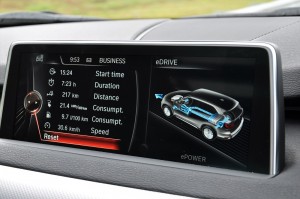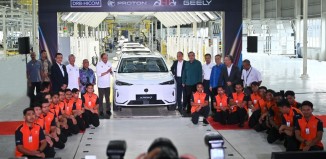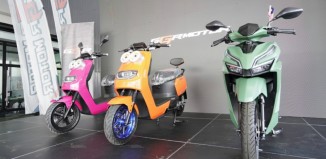BMW Group Malaysia Looks Forward To Building Local Capabilities And E-mobility
 In 2019, BMW Group Malaysia delivered a combined total of 11,657 units of its BMW, MINI and BMW Motorrad vehicles, from the introduction of 32 new model variants from across the brands. Out of the 32 models, four are electrified models. In Malaysia, this German premium automaker continues to reinforce its position as the leading e-mobility provider, selling a total of 3,148 electrified BMW and MINI vehicles last year.
In 2019, BMW Group Malaysia delivered a combined total of 11,657 units of its BMW, MINI and BMW Motorrad vehicles, from the introduction of 32 new model variants from across the brands. Out of the 32 models, four are electrified models. In Malaysia, this German premium automaker continues to reinforce its position as the leading e-mobility provider, selling a total of 3,148 electrified BMW and MINI vehicles last year.
 This brings the number of electrified BMW Group vehicles to over 17,000 units sold in the country since 2015. In comparison, BMW and MINI delivered a total of 145,815 electrified vehicles globally in 2019. “Against the backdrop of a challenging year for the automotive sector, we are proud to have achieved such success within the electrified segment in Malaysia and across the globe – which reaffirms our optimism for the year ahead. We are committed to continue leading the charge for electromobility in Malaysia, especially in light of the upcoming National Automotive Policy announcement that will see electrified vehicles play a prominent role in propelling our automotive sector to greater heights,” said Harald Hoelzl, Managing Director of BMW Group Malaysia.
This brings the number of electrified BMW Group vehicles to over 17,000 units sold in the country since 2015. In comparison, BMW and MINI delivered a total of 145,815 electrified vehicles globally in 2019. “Against the backdrop of a challenging year for the automotive sector, we are proud to have achieved such success within the electrified segment in Malaysia and across the globe – which reaffirms our optimism for the year ahead. We are committed to continue leading the charge for electromobility in Malaysia, especially in light of the upcoming National Automotive Policy announcement that will see electrified vehicles play a prominent role in propelling our automotive sector to greater heights,” said Harald Hoelzl, Managing Director of BMW Group Malaysia.
 Although the success of BMW Group reinforces the steady uptake of electromobility in Malaysia, there is still room for improvement. New technology is never cheap to implement and e-mobility requires heavy long-term investments in infrastructure. To help further the e-mobility agenda in the country, BMW Group Malaysia had initiated and involved itself in infrastructure expansion. In 2019, 18 new BMW i Charging Facilities were established across the country.
Although the success of BMW Group reinforces the steady uptake of electromobility in Malaysia, there is still room for improvement. New technology is never cheap to implement and e-mobility requires heavy long-term investments in infrastructure. To help further the e-mobility agenda in the country, BMW Group Malaysia had initiated and involved itself in infrastructure expansion. In 2019, 18 new BMW i Charging Facilities were established across the country.
That makes the total of over 30 BMW charging facilities in Malaysia, built in just over three years. Initiatives like this can only go as far or grow as big as governmental support allows, as this is heavy investment and commitment on the part of the company.
 That aside, last year, BMW sold 9,300 vehicles in Malaysia last year, down from five-figure sales in 2018. This is somewhat surprising as demand for premium brands is largely inelastic. Some may attribute this to many consumers having taken advantage of the tax holiday in 2018 to buy their cars, but BMW sales the year before (2017) were also in the five-figure range when there was no tax holiday.
That aside, last year, BMW sold 9,300 vehicles in Malaysia last year, down from five-figure sales in 2018. This is somewhat surprising as demand for premium brands is largely inelastic. Some may attribute this to many consumers having taken advantage of the tax holiday in 2018 to buy their cars, but BMW sales the year before (2017) were also in the five-figure range when there was no tax holiday.
Speculations aside, the 3 Series remains the brand’s top sales contributor with 2,514 units delivered. Of this number, over 1,000 was the BMW 330e M Sport plug-in hybrid, which drew buyers due to the attractive value afforded by government incentives. Another key contributor to BMW’s total deliveries in 2019 was the BMW 5 Series which saw over 2,000 new owners.
 Demand for SUVs remain strong in the market as well and BMW managed to deliver 3,985 units of the X family of SUVs to buyers. The BMW X3 was the highest contributing model for the year, with a delivery of 1,354 units, followed closely by the BMW X1 with 1,331 deliveries. The electrified BMW X5 xDrive40e also made up 24% (975 units) of total deliveries for the BMW X family, making it the third bestselling X model in 2019.
Demand for SUVs remain strong in the market as well and BMW managed to deliver 3,985 units of the X family of SUVs to buyers. The BMW X3 was the highest contributing model for the year, with a delivery of 1,354 units, followed closely by the BMW X1 with 1,331 deliveries. The electrified BMW X5 xDrive40e also made up 24% (975 units) of total deliveries for the BMW X family, making it the third bestselling X model in 2019.
 On a more minor scale, the MINI brand moved 1,142 vehicles last year, with the MINI Countryman contributing more than half of total deliveries (685 units). At the same time, BMW Motorrad delivered 1,125 motorcycles. The key contributor to growth remains the Adventure segment with over 600 bikes sold.
On a more minor scale, the MINI brand moved 1,142 vehicles last year, with the MINI Countryman contributing more than half of total deliveries (685 units). At the same time, BMW Motorrad delivered 1,125 motorcycles. The key contributor to growth remains the Adventure segment with over 600 bikes sold.
 Globally, the BMW Group enjoyed its ninth consecutive record year in 2019 with 2,520,307 vehicles delivered. The BMW brand reported a new all-time high last year, with a total of 2,168,516 delivered worldwide, in contrast to the contraction experienced in Malaysia.
Globally, the BMW Group enjoyed its ninth consecutive record year in 2019 with 2,520,307 vehicles delivered. The BMW brand reported a new all-time high last year, with a total of 2,168,516 delivered worldwide, in contrast to the contraction experienced in Malaysia.
Worldwide MINI brand deliveries totalled 346,639 units in 2019, while BMW Motorrad delivered 175,162 motorcycles to new owners.
For 2020, BMW Group Malaysia will continue driving its “Story of Visionary Mobility” forward, with a clear and continued commitment to drive initiatives for innovation, local assembly capabilities, and awareness on new and clean technology for the automotive industry as well as developing the infrastructure for premium vehicles in the country.
 BMW Group Malaysia has not only invested in the local assembly of vehicles for domestic consumption, it also exports to regional markets. Aiding this move is the Engine Assembly Facility, which is a joint initiative with the Sime Darby group.
BMW Group Malaysia has not only invested in the local assembly of vehicles for domestic consumption, it also exports to regional markets. Aiding this move is the Engine Assembly Facility, which is a joint initiative with the Sime Darby group.
Initiatives like this are not simple nor short term as it takes time and money over long periods to establish and see returns. Businesses also need to take into account the supply chain, volume and market potential before they make such investments. Also, it can take manufacturers up to five years or more to plan out the product line-up so it is a huge commitment for the long term for any manufacturer to set up a production base. But as we have seen recently with other brands, pulling out of a market takes a much shorter time than establishing it.
 “This year begins a new chapter for us and the nation in the Story of Visionary Mobility. 2020 is building up to be an exciting year of change in the automotive sector and we are thrilled to be a part of it. On behalf of BMW Group Malaysia, I would like to thank and extend our appreciation to all our customers, employees and dealer representatives in our network for our achievement, especially in challenging times. It clearly demonstrates the strength and resilience as One Team!” said Hoelzl.
“This year begins a new chapter for us and the nation in the Story of Visionary Mobility. 2020 is building up to be an exciting year of change in the automotive sector and we are thrilled to be a part of it. On behalf of BMW Group Malaysia, I would like to thank and extend our appreciation to all our customers, employees and dealer representatives in our network for our achievement, especially in challenging times. It clearly demonstrates the strength and resilience as One Team!” said Hoelzl.
 We are expecting the new National Automotive Policy (NAP) to be announced soon and it will be to our interest as a nation, as well as to businesses like BMW Group, how defined and welcoming the map is for attracting further investments and developing the automotive industry in Malaysia into a competitive regional and/or global player. This does not just involve having more automotive brands but bringing in more of the component makers, engineering and design houses, etc to support the respective brands in other markets.
We are expecting the new National Automotive Policy (NAP) to be announced soon and it will be to our interest as a nation, as well as to businesses like BMW Group, how defined and welcoming the map is for attracting further investments and developing the automotive industry in Malaysia into a competitive regional and/or global player. This does not just involve having more automotive brands but bringing in more of the component makers, engineering and design houses, etc to support the respective brands in other markets.
The effect of the Covid-19 outbreak shows how vulnerable supply chains can be when industries rely heavily on one production base. We have also seen a similar effect when natural calamities hit other major production bases. This is potentially an attractive proposition to market to foreign companies to place part of their operations here. But to draw the horse here, we need carrots.


























